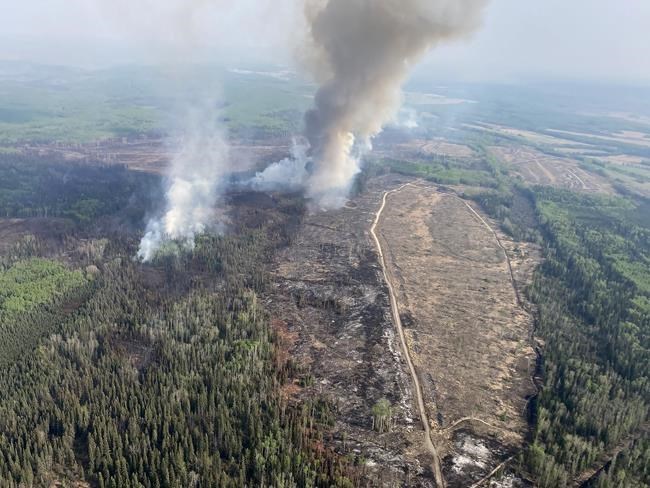FORT ST. JOHN, B.C. — Hundreds of firefighters are taking advantage of a weather break to prepare for a potential worsening of conditions near the wildfire-threatened city of Fort St. John in northeastern British Columbia, as the community of 21,000 remains on evacuation alert.
Hannah Swift, an information officer with the BC Wildfire Service, said 400 fire personnel, 22 pieces of heavy equipment and 22 helicopters were in the vicinity of four blazes close to the city.
"We have more resources arriving by the hour," she told a news briefing.
She said a break in the weather, in which winds dropped and shifted direction, had been "a bit of a reprieve" for Fort St. John and crews had used the opportunity to reassess and position themselves ahead of a warm front.
That new weather change, bringing hotter conditions and a potentially problematic wind shift, could arrive as soon as Wednesday evening, she said.
The calmer winds Tuesday had helped crews hold off the wildfires one day after winds gusting more than 60 kilometres per hour blew thick smoke over Fort St. John in a scene described by a resident as "controlled chaos."
"When the wind shifted and blew the entire smoke plume our way … it just pretty much settled right on top of the city," said Patrick Patterson, an IT worker in the city.
"And then the power went out at the same time, and then the evacuation alert came out at the same time. It was just a perfect storm."
Patterson said the evacuation alert notification, which encouraged residents to fill gas tanks to facilitate a possible evacuation, led to lineups of up to two hours at local pumps.
"It was not a good feeling," he said. "And then the wind really started gusting, too, and you could could barely see for a bit … There was a real sense of unease in the community, although everybody did their best to stay calm."
Fort St. John Mayor Lilia Hansen said the city saw blue and sunny skies Tuesday — a stark contrast to Monday.
“We had to kind of hold our breath and cross our fingers and the winds died down, so thank you to Mother Nature for that,” Hansen said.
The BC Wildfire Services said parts of British Columbia are already in the midst of their "core fire season," months ahead of schedule.
Cliff Chapman, the wildfire service's operations director, said at least 50,000 hectares of land has been burned in the province so far this year, several times more than the 10-year average of 11,000 hectares at this point in the season.
Chapman said dry weather in April and May, combined with the ongoing heat wave that has broken temperature records across B.C. and Alberta has created "very challenging" wildfire threats across the province, with the expected rain in June more pivotal to firefighting efforts than ever.
"We are now in a position … with our drying across the province and our fuels being so receptive to ignition and fire spread, that the June rains are the biggest variable for us as we head into the core fire season," he said.
"But obviously, as we as we sit here right now, we are in the core fire season in parts of the province."
The wildfire service website showed Tuesday that the Stoddart Creek wildfire outside Fort St. John has reached about 235 square kilometres in size, while the overlapping Red Creek fire is about 29 square kilometres.
Flames are 20 to 25 kilometres from Fort St. John.
Chapman warned that an abundance of black spruce, a timber that can fuel extremely fast fire spread, means residents must remain vigilant and ready to move on short notice.
Chapman said Monday's high winds pushed flames near Fort St. John to advance 12 kilometres in a 12-hour period.
Environment Canada heat warnings remain for inland sections of B.C.'s north coast but have been downgraded across much the rest of the province and Alberta.
— With files from Moose FM
This report by The Canadian Press was first published May 16, 2023.
Chuck Chiang, The Canadian Press



